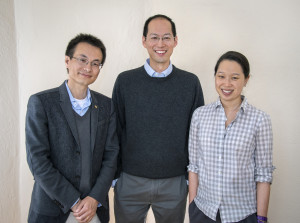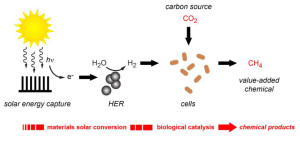A team of researchers at the U.S. Department of Energy (DOE)’s Lawrence Berkeley National Laboratory (Berkeley Lab) developing a bioinorganic hybrid approach to artificial photosynthesis have achieved another milestone. Having generated quite a buzz with their hybrid system of semiconducting nanowires and bacteria that used electrons to synthesize carbon dioxide into acetate, the team has now developed a hybrid system that produces renewable molecular hydrogen and uses it to synthesize carbon dioxide into methane, the primary constituent of natural gas.
“This study represents another key breakthrough in solar-to-chemical energy conversion efficiency and artificial photosynthesis,” says Peidong Yang, a chemist with Berkeley Lab’s Materials Sciences Division and one of the leaders of this study. “By generating renewable hydrogen and feeding it to microbes for the production of methane, we can now expect an electrical-to-chemical efficiency of better than 50 percent and a solar-to-chemical energy conversion efficiency of 10-percent if our system is coupled with state-of-art solar panel and electrolyzer.”
Yang, who also holds appointments with UC Berkeley and the Kavli Energy NanoScience Institute (Kavli-ENSI) at Berkeley, is one of three corresponding authors of a paper describing this research in the Proceedings of the National Academy of Sciences (PNAS). The paper is titled “A hybrid bioinorganic approach to solar-to-chemical conversion.” The other corresponding authors are Michelle Chang and Christopher Chang. Both also hold joint appointments with Berkeley Lab and UC Berkeley. In addition, Chris Chang is a Howard Hughes Medical Institute (HHMI) investigator. (See below for a full list of the paper’s authors.)
Photosynthesis is the process by which nature harvests the energy in sunlight and uses it to synthesize carbohydrates from carbon dioxide and water. Carbohyrates are biomolecules that store the chemical energy used by living cells. In the original hybrid artificial photosynthesis system developed by the Berkeley Lab team, an array of silicon and titanium oxide nanowires collected solar energy and delivered electrons to microbes which used them to reduce carbon dioxide into a variety of value-added chemical products. In the new system, solar energy is used to split the water molecule into molecular oxygen and hydrogen. The hydrogen is then transported to microbes that use it to reduce carbon dioxide into one specific chemical product, methane.

(From left) Peidong Yang, Christopher Chang and Michelle Chang led the development of an artificial photosynthesis system that can convert CO2 into valuable chemical products using only water and sunlight. (Photo by Roy Kaltschmidt)
“In our latest work, we’ve demonstrated two key advances,” says Chris Chang. “First, our use of renewable hydrogen for carbon dioxide fixation opens up the possibility of using hydrogen that comes from any sustainable energy source, including wind, hydrothermal and nuclear. Second, having demonstrated one promising organism for using renewable hydrogen, we can now, through synthetic biology, expand to other organisms and other value-added chemical products.”
The concept in the two studies is essentially the same – a membrane of semiconductor nanowires that can harness solar energy is populated with bacterium that can feed off this energy and use it to produce a targeted carbon-based chemical. In the new study, the membrane consisted of indium phosphide photocathodes and titanium dioxide photoanodes. Whereas in the first study, the team worked with Sporomusa ovata, an anaerobic bacterium that readily accepts electrons from the surrounding environment to reduce carbon dioxide, in the new study the team populated the membrane with Methanosarcina barkeri, an anaerobic archaeon that reduces carbon dioxide using hydrogen rather than electrons.
“Using hydrogen as the energy carrier rather than electrons makes for a much more efficient process as molecular hydrogen, through its chemical bonds, has a much higher density for storing and transporting energy,” says Michelle Chang.
In the newest membrane reported by the Berkeley team, solar energy is absorbed and used to generate hydrogen from water via the hydrogen evolution reaction (HER). The HER is catalyzed by earth-abundant nickel sulfide nanoparticles that operate effectively under biologically compatible conditions. Hydrogen produced in the HER is directly utilized by the Methanosarcina barkeri archaeons in the membrane to produce methane.

A major advance in artificial photosynthesis poses win/win for the environment – removing CO2 from the atmosphere and using it for green chemistry, including renewable fuel production. (Photo by Caitlin Givens)
“We selected methane as an initial target owing to the ease of product separation, the potential for integration into existing infrastructures for the delivery and use of natural gas, and the fact that direct conversion of carbon dioxide to methane with synthetic catalysts has proven to be a formidable challenge,” says Chris Chang. “Since we still get the majority of our methane from natural gas, a fossil fuel, often from fracking, the ability to generate methane from a renewable hydrogen source is another important advance.”
Adds Yang, “While we were inspired by the process of natural photosynthesis and continue to learn from it, by adding nanotechnology to help improve the efficiency of natural systems we are showing that sometimes we can do even better than nature.”
In addition to the corresponding authors, other co-authors of the PNAS paper describing this research were Eva Nichols, Joseph Gallagher, Chong Liu, Yude Su, Joaquin Resasco, Yi Yu and Yujie Sung.
This research was primarily funded by the DOE Office of Science.
Additional Information
For more about the research of Peidong Yang go here
For more about the research of Christopher Chang go here
For more about the research of Michelle Chang go here
# # #
Lawrence Berkeley National Laboratory addresses the world’s most urgent scientific challenges by advancing sustainable energy, protecting human health, creating new materials, and revealing the origin and fate of the universe. Founded in 1931, Berkeley Lab’s scientific expertise has been recognized with 13 Nobel prizes. The University of California manages Berkeley Lab for the U.S. Department of Energy’s Office of Science. For more, visit www.lbl.gov.
DOE’s Office of Science is the single largest supporter of basic research in the physical sciences in the United States, and is working to address some of the most pressing challenges of our time. For more information, please visit the Office of Science website at science.energy.gov/.

